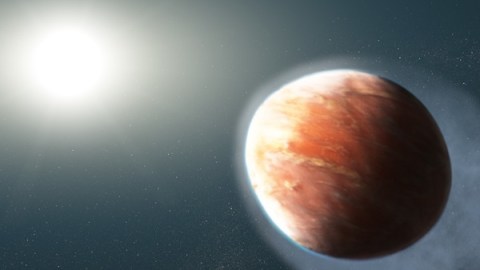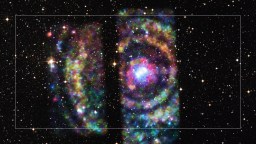Astronomers find a planet so hot it’s streaming metals into space

NASA/ESA/J. Olmsted/STScI
- Astronomers study the exoplanet planet WASP-121b that’s known as a “hot Jupiter.”
- The planet is so hot, metals like iron and magnesium stream off its surface.
- The find is the latest accomplishment using the Hubble Space Telescope.
For the first time ever, astronomers spotted a planet that is so hot it’s leaking heavy metals like iron and magnesium into space. The upper atmosphere of WASP-121b, an exoplanet shaped like a football is 10 times hotter than on any exoplanet we have so far been able to measure.
Astronomers employed NASA’s Hubble Space Telescope to gauge of the temperature the unusual space body that’s about 900 light-years away from Earth. They found that heavy metals are streaming behind WASP-121b as every 30 hours it orbits its star, which is smaller but hotter than our sun.
A planet like this one, located outside our solar system, has been called a ‘hot Jupiter” – a class of giant exoplanets full of mostly hydrogen and helium gas. While physically similar to Jupiter, they have much shorter orbital periods which can be just hours or a few days. They are also close to their stars and feature super-high surface temperatures.
WASP-121b is hot even by hot Jupiter standards. With temperatures of about 4,600 degrees Fahrenheit, the planet is melting metals, which along with lighter materials fly off its surface.
Being near a star with a massive gravitational pull can also warp such a planet. In the case of WASP-121b, its been stretched out to look like a football.
The study of the planet, published in the Astronomical Journal, was led by David Sing of the Johns Hopkins University in Baltimore, Maryland.
“Heavy metals have been seen in other hot Jupiters before, but only in the lower atmosphere,” said Sing. “So you don’t know if they are escaping or not. With WASP-121b, we see magnesium and iron gas so far away from the planet that they’re not gravitationally bound.”
Astronomers believe that planets don’t start out being hot Jupiters, as it would be hard for them to be formed under such conditions. Instead, they are created elsewhere but over time migrate closer to stars which start pulling away their outer layers. Future tech like the James Webb Space Telescope will be able to tell us much more about these gigantic space fireballs.





